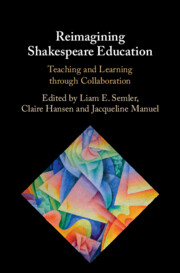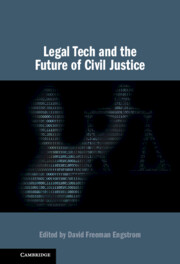Refine search
Actions for selected content:
2860 results in Computing and Society
Part II - Polycentricity and Urban Data
-
- Book:
- Governing Smart Cities as Knowledge Commons
- Published online:
- 18 February 2023
- Print publication:
- 09 February 2023, pp 81-220
-
- Chapter
-
- You have access
- Open access
- HTML
- Export citation
Conclusion
- from Part IV - Lessons for Smart Cities
-
-
- Book:
- Governing Smart Cities as Knowledge Commons
- Published online:
- 18 February 2023
- Print publication:
- 09 February 2023, pp 309-320
-
- Chapter
-
- You have access
- Open access
- HTML
- Export citation
3 - Open Governments, Open Data
- from Part I - Social Dilemmas around Urban Data
-
-
- Book:
- Governing Smart Cities as Knowledge Commons
- Published online:
- 18 February 2023
- Print publication:
- 09 February 2023, pp 58-80
-
- Chapter
-
- You have access
- Open access
- HTML
- Export citation
1 - Smart Cities and Knowledge Commons
-
-
- Book:
- Governing Smart Cities as Knowledge Commons
- Published online:
- 18 February 2023
- Print publication:
- 09 February 2023, pp 6-26
-
- Chapter
-
- You have access
- Open access
- HTML
- Export citation
1 - The Future of American Legal Tech
- from Part I - Legal Tech and the Innovation Ecosystem
-
-
- Book:
- Legal Tech and the Future of Civil Justice
- Published online:
- 02 February 2023
- Print publication:
- 09 February 2023, pp 21-43
-
- Chapter
-
- You have access
- Open access
- HTML
- Export citation
4 - Remote Testimonial Fact-Finding
- from Part II - Legal Tech, Litigation, and the Adversarial System
-
-
- Book:
- Legal Tech and the Future of Civil Justice
- Published online:
- 02 February 2023
- Print publication:
- 09 February 2023, pp 93-111
-
- Chapter
-
- You have access
- Open access
- HTML
- Export citation
6 - Legal Tech and the Litigation Playing Field
- from Part II - Legal Tech, Litigation, and the Adversarial System
-
-
- Book:
- Legal Tech and the Future of Civil Justice
- Published online:
- 02 February 2023
- Print publication:
- 09 February 2023, pp 133-154
-
- Chapter
-
- You have access
- Open access
- HTML
- Export citation
Introduction
-
-
- Book:
- Legal Tech and the Future of Civil Justice
- Published online:
- 02 February 2023
- Print publication:
- 09 February 2023, pp 1-18
-
- Chapter
-
- You have access
- Open access
- HTML
- Export citation
Part IV - Lessons for Smart Cities
-
- Book:
- Governing Smart Cities as Knowledge Commons
- Published online:
- 18 February 2023
- Print publication:
- 09 February 2023, pp 293-294
-
- Chapter
-
- You have access
- Open access
- HTML
- Export citation
10 - Digital Inequalities and Access to Justice
- from Part III - Legal Tech and Access to Justice
-
-
- Book:
- Legal Tech and the Future of Civil Justice
- Published online:
- 02 February 2023
- Print publication:
- 09 February 2023, pp 225-250
-
- Chapter
-
- You have access
- Open access
- HTML
- Export citation
Part III - Private Influence on Decision-Making
-
- Book:
- Governing Smart Cities as Knowledge Commons
- Published online:
- 18 February 2023
- Print publication:
- 09 February 2023, pp 221-292
-
- Chapter
-
- You have access
- Open access
- HTML
- Export citation
9 - The Supply and Demand of Legal Help on the Internet
- from Part III - Legal Tech and Access to Justice
-
-
- Book:
- Legal Tech and the Future of Civil Justice
- Published online:
- 02 February 2023
- Print publication:
- 09 February 2023, pp 199-224
-
- Chapter
-
- You have access
- Open access
- HTML
- Export citation
4 - Community Land Trusts as a Knowledge Commons
- from Part II - Polycentricity and Urban Data
-
-
- Book:
- Governing Smart Cities as Knowledge Commons
- Published online:
- 18 February 2023
- Print publication:
- 09 February 2023, pp 83-111
-
- Chapter
-
- You have access
- Open access
- HTML
- Export citation
Contributors
-
- Book:
- Legal Tech and the Future of Civil Justice
- Published online:
- 02 February 2023
- Print publication:
- 09 February 2023, pp xi-xvi
-
- Chapter
-
- You have access
- Open access
- HTML
- Export citation
Part II - Legal Tech, Litigation, and the Adversarial System
-
- Book:
- Legal Tech and the Future of Civil Justice
- Published online:
- 02 February 2023
- Print publication:
- 09 February 2023, pp 91-196
-
- Chapter
-
- You have access
- Open access
- HTML
- Export citation
14 - Free PACER
- from Part IV - Courts, Data, and Civil Justice
-
-
- Book:
- Legal Tech and the Future of Civil Justice
- Published online:
- 02 February 2023
- Print publication:
- 09 February 2023, pp 328-348
-
- Chapter
-
- You have access
- Open access
- HTML
- Export citation
Figures
-
- Book:
- Legal Tech and the Future of Civil Justice
- Published online:
- 02 February 2023
- Print publication:
- 09 February 2023, pp vii-viii
-
- Chapter
-
- You have access
- Open access
- HTML
- Export citation

Reimagining Shakespeare Education
- Teaching and Learning through Collaboration
-
- Published online:
- 02 February 2023
- Print publication:
- 23 February 2023

Legal Tech and the Future of Civil Justice
-
- Published online:
- 02 February 2023
- Print publication:
- 09 February 2023
-
- Book
-
- You have access
- Open access
- Export citation

The E-Primer
- An Introduction to Creating Psychological Experiments in E-Prime
-
- Published by:
- Amsterdam University Press
- Published online:
- 22 November 2022
- Print publication:
- 04 March 2019
-
- Book
- Export citation
